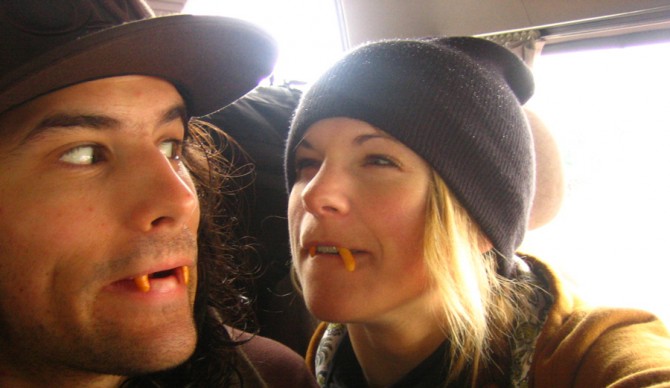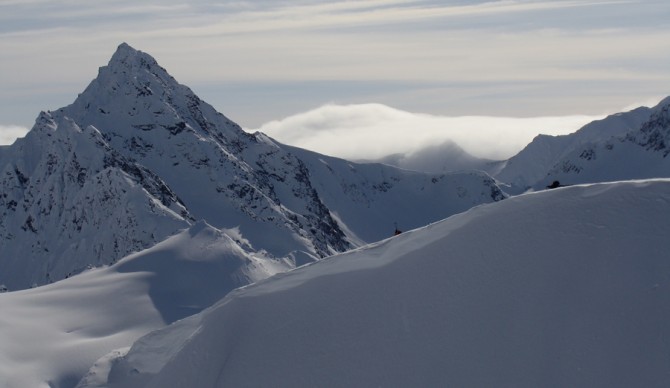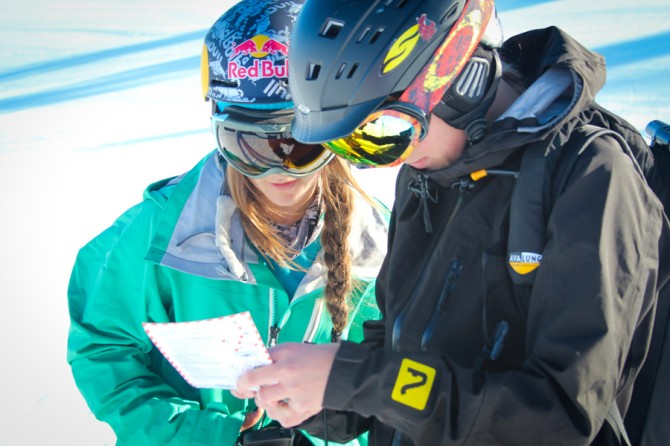
Argentina in 2013, skinning up to get down. I coach at SASS Global Travel in Argentina. Been heading south for 9 years straight. Love it. Photo: Courtesy of Michelle Parker
I grew up in Lake Tahoe in California — at Squaw Valley in particular. Growing up there, I was constantly surrounded by a bunch of massive influencers in the skiing industry on the athlete side. I was actually racing at the time, but when I was about 15 I realized that I just loved skiing powder more.
I actually felt like I was losing a little freedom to roam while I was racing, so I decided to break away from that. But before I found powder, I got noticed right away for skiing in the park. With the encouragement, I tried competing in the park for a little while, and it was awesome, but it quickly grew stale for me.
I wanted to ski the entire mountain. I wanted to ski with my friends. But, above all, I wanted to ski powder.
Today, what inspires me about big mountain free skiing is the freedom that you have out there, and the environment that you’re in, and the extra environment that you create with you friends. We are all working as a team in a way you don’t when competing in contests — but that doesn’t mean everyone isn’t pushing each other. We’re hyperaware of what is going on, including with the rest of the crew; if I get caught in an avalanche, one of my big mountain skiers that is with me is the one that’s going to save my life. We’re working together, helping one another look for and choose lines from each of our different vantage points, sharing our individual knowledge and experience. But these are realizations I’ve come to over the past few years. Before this, I simply knew I didn’t want to be limited to the park.
Thus, I was at this crossroads. And instead of continuing with park, I focused on what I wanted to do. Influenced and encouraged by JP Auclair, I finally took initiative and went to guide school up in Haines, Alaska. JP and I were teammates for about eight years. We traveled a lot together, and he had always been really supportive of my desire to break into the big mountain scene, with filming, etc.

JP Auclair and myself in Japan. We traveled around the world for years together as we shared the same sponsor. Definitely a huge role model in my life and still has great influence on me. Photo: Courtesy of Michelle Parker
He told me I had to start with the safety aspects of it — and this was at a time when that wasn’t necessarily common practice. I was rather young, maybe 20 years old, when I did guide school.
Anyway, that was basically your Avalanche Level 1, your avy rescue and a little medical training, including advanced wilderness first aid. I went up there and took that course with the intentions of being able to start my big mountain skiing career having that knowledge base that’s essential to being able to kind of more or less stand on your own two feet while you’re out there — not being dependent on other people. Even though a lot of the time I’m out there with a guide, I think it is important to have your own (knowledgable) head on your shoulders and be able to listen to yourself rather than always depending on other people. And being a female in the industry, I figured it was probably a good move to kind of start learning, to avoid any misappropriated hesitations from a mostly male crew.

2008 in Haines AK my first trip to Alaska for guide school. Photo: Courtesy of Michelle Parker
At the beginning, it was something of a struggle getting the support from my sponsors to get into big mountain free skiing. You see, at the time, I was competing very successfully at slope style and half pipe. I was competitive in the park contests, placing well and making my name for myself, which, again, was good for and important to my sponsors, but they weren’t entertaining to me. I was inspired when I was skiing in the mountains, and the park skiing simply wasn’t doing that for me anymore. It was fun, but there was a longing that I felt needed to be filled. It wasn’t until six years into my career that I finally got the support I needed to go film — that was huge for me as I was splitting time and it was difficult to put together a truly strong season edit, with the winter being only so long, so it was a big step towards realizing that dream in that I now got to dedicate my whole season to it.
There were still obstacles to overcome, however. When I finally got the support and started filming, I blew my knee out. To be honest, that was a bigger wake up call than I had ever experienced before. I had already had ACL injury, and this one demolished everything. At that point in my career, I was still making that transition over to big mountain free skiing and a lot of my sponsors weren’t totally behind me. Also, when I was coming back from that injury was when they announced that the Olympics would be on for Sochi for half pipe and slope style. That signaled a shift in the industry towards pushing and getting behind park skiers.
I was lost. I didn’t know what to do. Do I want to aim for the Olympics? (There wasn’t a doubt in my mind that I could compete with anyone and everyone.) Or do I completely remove myself from the contest and follow my real true passion, big mountain free skiing? Ultimately, I decided to do that: pursue my dream. In turn, though, a lot of those sponsors I mentioned before moved on in support of athletes that were going to the Olympics.
So there I was with no sponsors. But that didn’t matter to me. I was pursuing my dream and that mattered more than having to start over again in the way of sponsors. That is when I called up Matchstick. Earlier on in my career, when I was still splitting time and competing in contests, I had gotten injured on a Matchstick shoot. One of the cinematographers who I had worked with, Steve Reska, immediately responded saying that they would love for me to join them on a shoot, and support me! He ended up playing a critical role in helping me get back on me feet, aligning me with most of the current sponsors I have right now.
And that what I was looking for out of skiing — a community of people who shared this passion. What keeps inspiring me are the people that I film. You don’t wake up one morning and decide to be a big mountain skier. There is too much to know about the mountains and about nature, from snowpack and avalanche danger to how you ride a line. There is always room to improve. And I’m on that journey with my best friends.

A shot of teaching avalanche workshops in Squaw Valley. Photo: Courtesy of Michelle Parker
My life has evolved, and that is directly related to skiing, especially in these big mountains. When I was younger, I was getting way too far ahead of myself and wasn’t able to put things into perspective. So I would look at a mountain and see a line and think I could totally ski it. Then J.P. would call me out: “What are you talking about? That is like a 100 foot cliff.” I couldn’t tell. Think of when you’re walking in Vegas and you see the hotel that’s on the opposite side of the strip and you’re looking at it and you think it’s super close. But then you start walking and it takes like an hour to get there — that’s how Alaska is. You have to adjust your depth perception to realize how big the lines and cliffs really are. And because of that you get spanked a couple times skiing down and hitting stuff that you thought was really small when it was really big. All the elements of skiing are amplified in a big mountain setting, especially in Alaska. You have really steep faces and the slough is running way faster. I’ve made the classic mistake of getting taken out by slough my first couple of times in Alaska — slough management is key. Through it all you learn invaluable lessons as you’re falling down thousand foot faces or you’re getting taken out by unprecedented slough that looks like an avalanche. The challenges you face as a big mountain skier are forever present, but they are also what make you a better (and smarter) skier, making you focus your energy in a positive manner.

009 Mustang Powder. Beautiful light with MSP. Photo: Courtesy of Michelle Parker
As I get older, I realize that when I was competing in slope style, I had this mentality of wanting to win everything. At the end of the day, though, I realize that third or even first place didn’t make me a better person. In the larger scheme of things, it didn’t matter. But with big mountain, I felt and feel better, like I was doing it for myself. It might be my livelihood and I obviously take it seriously, but I’ve been lucky enough to make it about what I want — and what I want to do is have the most fun possible and go out there with my friends and definitely get an adrenaline rush every once in a while. I want to ski pow. There isn’t much more to it. It has been kind of easy for me to keep that into perspective. Sure there are times when I feel these different pressures — that is when I remind myself to breathe. I’ve been engrained with the avalanche training and the training in group dynamics and other aspects of avalanche awareness force me to go through everything super thoroughly. And every time the segments come out, it’s like I know that was cool, but I know I can do better now that I have moreexperience. So I haven’t really reached my peak as a skier — and that keeps me going, and wanting to go.

Dropping in. Whistler in 2013. The view from the top. Photo: Courtesy of Michelle Parker
To keep up with Michelle Parker, be sure to follow her on Instagram and Twitter as well as Like her on Facebook.
For information and registration for a women’s avalanche workshop she is running, look into SAFE-AS by visiting SAFEASClinics.org.

